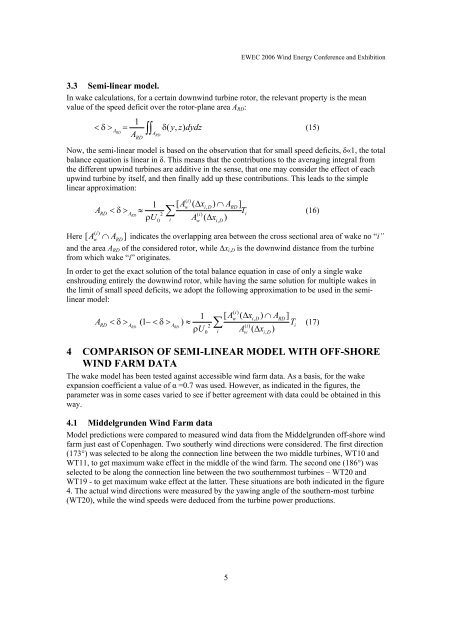Turbine Wake Model for Wind Resource Software
Turbine Wake Model for Wind Resource Software
Turbine Wake Model for Wind Resource Software
You also want an ePaper? Increase the reach of your titles
YUMPU automatically turns print PDFs into web optimized ePapers that Google loves.
EWEC 2006 <strong>Wind</strong> Energy Conference and Exhibition<br />
3.3 Semi-linear model.<br />
In wake calculations, <strong>for</strong> a certain downwind turbine rotor, the relevant property is the mean<br />
value of the speed deficit over the rotor-plane area A RD :<br />
1<br />
<br />
A<br />
= ∫∫ δ( y, zdydz )<br />
(15)<br />
RD<br />
A<br />
ARD<br />
RD<br />
Now, the semi-linear model is based on the observation that <strong>for</strong> small speed deficits, δ«1, the total<br />
balance equation is linear in δ. This means that the contributions to the averaging integral from<br />
the different upwind turbines are additive in the sense, that one may consider the effect of each<br />
upwind turbine by itself, and then finally add up these contributions. This leads to the simple<br />
linear approximation:<br />
A<br />
() i<br />
1 [ Aw ( Δxi,<br />
D) ∩ARD]<br />
RD<br />
<br />
A<br />
≈ T<br />
RD 2 ( i)<br />
i<br />
ρ U0 i Aw ( Δ xi,<br />
D)<br />
∑ (16)<br />
() i<br />
Here [ Aw<br />
∩ A<br />
RD]<br />
indicates the overlapping area between the cross sectional area of wake no “i”<br />
and the area A RD of the considered rotor, while Δx i,D is the downwind distance from the turbine<br />
from which wake “i” originates.<br />
In order to get the exact solution of the total balance equation in case of only a single wake<br />
enshrouding entirely the downwind rotor, while having the same solution <strong>for</strong> multiple wakes in<br />
the limit of small speed deficits, we adopt the following approximation to be used in the semilinear<br />
model:<br />
A<br />
() i<br />
1 [ Aw ( Δxi,<br />
D) ∩ARD]<br />
RD<br />
<br />
A<br />
(1 − )<br />
RD<br />
A<br />
≈ T<br />
RD<br />
2 ( i)<br />
i<br />
ρ U0 i Aw ( Δ xi,<br />
D)<br />
∑ (17)<br />
4 COMPARISON OF SEMI-LINEAR MODEL WITH OFF-SHORE<br />
WIND FARM DATA<br />
The wake model has been tested against accessible wind farm data. As a basis, <strong>for</strong> the wake<br />
expansion coefficient a value of α =0.7 was used. However, as indicated in the figures, the<br />
parameter was in some cases varied to see if better agreement with data could be obtained in this<br />
way.<br />
4.1 Middelgrunden <strong>Wind</strong> Farm data<br />
<strong>Model</strong> predictions were compared to measured wind data from the Middelgrunden off-shore wind<br />
farm just east of Copenhagen. Two southerly wind directions were considered. The first direction<br />
(173°) was selected to be along the connection line between the two middle turbines, WT10 and<br />
WT11, to get maximum wake effect in the middle of the wind farm. The second one (186°) was<br />
selected to be along the connection line between the two southernmost turbines – WT20 and<br />
WT19 - to get maximum wake effect at the latter. These situations are both indicated in the figure<br />
4. The actual wind directions were measured by the yawing angle of the southern-most turbine<br />
(WT20), while the wind speeds were deduced from the turbine power productions.<br />
5
















